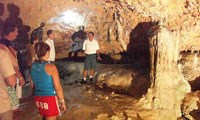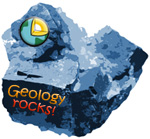Cuevas de Bellamar EarthCache
-
Difficulty:
-

-
Terrain:
-

Size:  (other)
(other)
Please note Use of geocaching.com services is subject to the terms and conditions
in our disclaimer.
Thousands of foreign travelers and local people visit the Bellamar Caves in Cuba, the largest of the Antillean Islands.
TRAVELLERS ARE NOT ALLOWED TO BRING GPS SYSTEMS TO CUBA, AT THE TIME OF WRITING
This site is well marked on maps and Google Earth, and is included in many tours. It is a stunning ‘experience’’ which is well worth time away from the beaches and the cities.
PLEASE BE AWARE THAT THIS IS NOT A "24/7" FACILITY. I ADVISE THAT YOU CHECK THE OPENING HOURS IN ADVANCE

Cuba, land of limestone and caves is one of the largest islands in the Antilles, about 1250km long and between 191 and 31km wide. It is a country about the size of England. Limestone forms 66% of the landscape, much of which is well developed mogote and cone karst.
The Havana and Matanzas Highlands and the Santa Clara Hills are underlain by folded and faulted sedimentary bedrock. Sandstones, conglomerates, shales, and dolomites of Cretaceous and Tertiary age are predominant. These remarkable caves are set in the Matanzas karst to the east of Havana.
They were discovered in the 19th century According to legend, the caves were discovered by accident in 1861, when a slave working in a Matanzas quarry lost ihis crow-bar into a hole in the ground, where later excavations unearthed a fantastical natural treasure.
I would recommend this contemporanious article from Harper's New Monthly Magazine, Vol 41, Issue 246, November 1870, pp. 826-834, Harper & Bros. New York. Click here to go to this interesting article.
The Bellamar Caves are nearly two kilometers long and feature many crystalline formations, including a lot of stalagmites and stalactites in salons that go deeper into the aquifer, ending in lakes of crystal-clear waters. Formed 300,000 years ago, the Bellamar Caves are made up of three caverns that were one whole cave in ancient times: Bellamar, El Jarrito and Soto Jíbaro.
Expert tour guides you along the caves' galleries, where they can visit unique sites such as "the American woman's bath" or "the fountain of youth".
The tour includes six halls and seventeen galleries of incredible beauty, fountains, stalactites and stalagmites, crystallised domes and other formations bearing names such as La Fuente del Amor (Fountain of Love) and La Galerna Coco Rallado (Grated Coconut Gallery). The constant dripping of the water that seeps from the caves's inner walls ensures 100-percent relative humidity.
The temperature in the caves ranges between 25° and 27°C. The tour is about 750 metres long with a descent and ascent of about 150 concrete steps to a maximum depth of 85 metres. (This why the climbing attribute has be ticked)
The ancient galleries were a safe haven for the region's quaternary fauna, a fact that has been confirmed by findings of such prehistoric animals during excavations.
Other caves, within the system, hold the largest phreatic stratum in Cuba. Solution cavities in limestone may be completely water filled, this is called the phreatic zone. Water in the phreatic zone may be relatively still or it may be moving quickly under pressure (dynamic phreatic). No 'dripping' is possible into water filled caverns.
How caves form
Caves, and other karst features, are produced because limestone is soluble in water containing dissolved carbon dioxide and organic acids. Rain picks up atmospheric carbon dioxide as it falls. On passing through the soil more carbon dioxide, from plant roots and decaying vegetable matter becomes dissolved in the water, along with complex organic acids called humic acids.
This ground water is easily able to dissolve limestone.
Karst can be defined as a landscape formed mainly by rock being dissolved. and is named after an area in Yugoslavia, The name is derived from a Slavic word meaning "bare and waterless".
Karst landforms are a labyrinthine terrain incorporating the composite elements of air, water and minerals supporting diverse biological components.
Cuba’s limestones, which contain large cave systems, have few pore spaces in it restricting ground water movement to planes of weakness in the rock (joints, bedding planes and faults). This concentrates solution to structurally controlled zones, rather than allowing solution to be spread evenly throughout the rock.
The solubility of the rock, its mechanical strength and the restriction of solution to structurally controlled zones combine to allow the formation of large, complex cave systems. Stalactites and stalagmites
Cave structures formed by the deposition of calcite dissolved in ground water, which drips into air-filled spaces.
Stalactites grow downwards from the roofs or walls and can be icicle-shaped, straw-shaped, curtain-shaped, or formed as terraces.
Stalagmites grow upwards from the cave floor and can be conical, fir-cone-shaped, or resemble a stack of saucers. Growing stalactites and stalagmites may meet to form a continuous column from floor to ceiling.

Stalactites are formed when ground water, hanging as a drip, loses a proportion of its carbon dioxide into the air of the cave. This reduces the amount of calcite that can be held in solution, and a small trace of calcite is deposited. Successive drips build up the stalactite over many years.
In stalagmite formation the calcite comes out of the solution because of agitation – the shock of a drop of water hitting the floor is sufficient to remove some calcite from the drop. The different shapes result from the splashing of the falling water.
Please EMAIL me the answers ~ From the guidelines: You do not need to wait for permission to log. Requiring someone to wait is not supported by the EarthCache guidelines. You should send your logging task answers , then log the EarthCache. When I review your logging task answers, if there is a problem, I will contact you to resolve it. If there is no problem, then your log simply stands."
Don't include the answers in your log even in an encrypted form.
1. What can be inferred about a cavern by the presence of stalactites and stalagmites?
2. From description the last paragraph, what is the first cave structure you see on the right hand-side as you descend ~ stalagmite, stalactite or column? And how big is it?
3. How much does it cost to take a camera with you, underground?
As a memento of your visit, IT WOULD BE NICE to take a picture that includes you and one of the old electrical fittings around the ceiling of the cave.
Upload it with you log, if you want.


Additional Hints
(Decrypt)
Jrne frafvoyr sbbgjrne - nibvq syvc-sybcf!!!